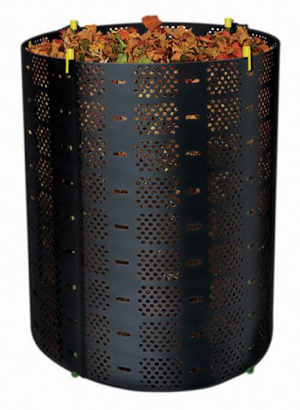How To Compost (6 Easy Steps!)
Even though we have a tiny urban backyard Jon and I are totally into composting! It's really not hard and it's good for the earth, so since we're finally in spring planting season I want to share 6 simple tips for how to compost.
1. Get an indoor compost receptacle
This is an optional step but handy step. An indoor compost receptacle allows you to collect kitchen scraps to reduce trips to your outdoor composter. I use the Full Circle Fresh Air composter and LOVE IT.
2. Get an outdoor composter
Composters range from simple to fancier (we have one simple + one fancier); here are some options to consider:
We bought our "simple" composter at our town DPW for around $30 I think. It's basically a cylinder with a cone inside (to allow for airflow) and a cone lid with a rope handle. If your DPW doesn't sell composters the Geobin Composter is an inexpensive. The only thing I'm wondering about is a lid, to keep animals out.
Image credit: Amazon
Our "fancy" composter (the EnviroCycle Composter) is out of stock but the Good Ideas EnviroTumbler is very similar. The composter rolls off the base so you can roll it to where you need it in the garden + the base collects the compost "tea," which we pour over our plants that need extra love.
Image credit: Amazon
For a more mid-range model, check out the Forest City Tumbling Composter. This composter has two chambers (let one sit while you fill the other) and a good ventilation system.
3. Collect your kitchen scraps!
In your indoor composter, collect green matter: fruit and veggie scraps, coffee grounds/filters, tea bags, and egg shells; the coffee grounds, tea bags, and egg shells offer excellent nutrients for compost. Do not include non-plant matter (e.g., meat, beans), which will attract animals.
4. Mix it up
Dump your kitchen compost into your outdoor compost and add some brown matter to it (e.g., dead leaves). And when you're watering your plants, water the compost. Ideally you want a mix of brown and green matter and also water; the brown matter provides carbon, the green nitrogen, and the water moistens the mix to facilitate breakdown.
5. Add earthworms!
My friend Braden (a longtime avid urban gardener) recommends adding earthworms as they are excellent compost helpers! She bought hers in New York City at an urban composting store.
6. Turn and use
If you have one composter, you'll need to dig up the "black gold" from the bottom or, if you have a rotating composter, rotate away! We have also LOVED having a second composter because this way we can be extra lazy; we fill one composter through the year and let the other decompose and then switch the next year. We either use compost for new plantings (dig a hole and line it with compost) or it's been great to spread compost + compost tea on existing plants as they've been coming back to life after the long winter.
For more information, you can check out the EPA’s guide to composting, but really, these easy steps have carried us through many years of urban composting. If you have questions, let me know in the comments!
Image credit: Pixabay





